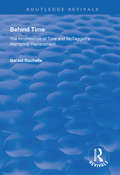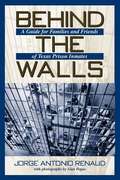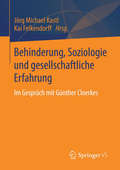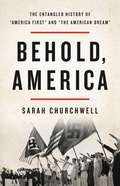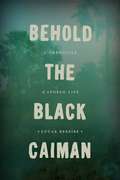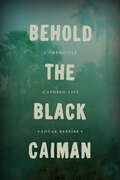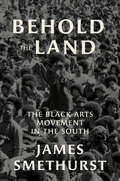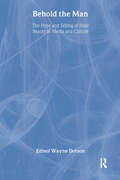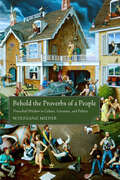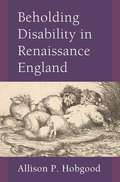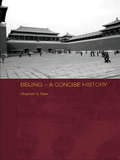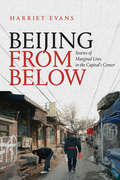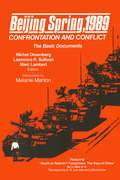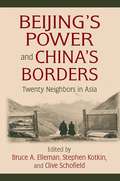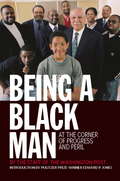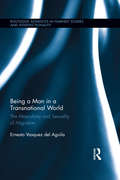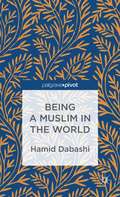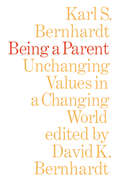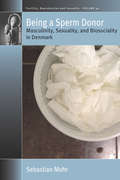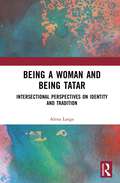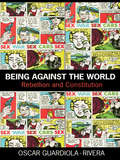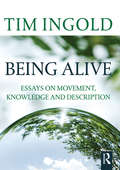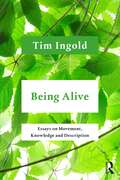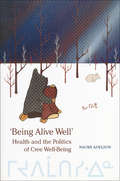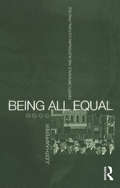- Table View
- List View
Behind Time: Incoherence of Time and McTaggart's Atemporal Replacement (Routledge Revivals)
by Gerald RochelleFirst published in 1998, this volume responded to and evaluated criticisms of McTaggart’s atemporal philosophy of time. Established philosophical positions on time had positioned themselves in relation to either the A Series (past, present and future) or the B Series (earlier and later). McTaggart considered both series untenable and proposed his own, atemporal C Series. Beginning with an overview of McTaggart’s position, Gerald Rochelle attempts to reinforce the seriousness of, and think beyond, McTaggart’s attempt to describe a world without time through an assessment of McTaggart’s criticisms and his suggested alternative. Rochelle argues that McTaggart’s atemporal world constitutes a strong foundation for a new theory on time which breaks away from the existing philosophical models of temporality.
Behind The Walls: A Guide For Families And Friends Of Texas Prison Inmates
by Jorge Antonio RenaudBehind the Walls is a detailed description of the world's largest prison system by a long-time convict trained as an observer and reporter. It spotlights the day-to-day workings of the Texas Department of Criminal Justice--what's good, what's bad, which programs work and which ones do not, and examines if practice really follows official policy. Written to inform about the processes, services, activities, issues, and problems of being incarcerated, this book is invaluable to anyone who has a relative or friend incarcerated in Texas, or for those who want to understand how prisoners live, eat, work, play, and die in a contemporary U.S. prison. Containing a short history of Texas prisons and advice on how to help inmates get out and stay out of prison, this book is the only one of its kind--written by a convict still incarcerated and dedicated to dispelling the ignorance and fear that shroud Texas prisons. Renaud discusses living quarters, food, and clothing, along with how prisoners handle money, mail, visits, and phone calls. He explores the issues of drugs, racism, gangs, and violence as well as what an inmate can learn about his parole, custody levels, and how to handle emergencies. What opportunities are available for education? What is the official policy for discipline? What is a lockdown? These questions and many others are answered in this one-of-a-kind guide.
Behinderung, Soziologie und gesellschaftliche Erfahrung: Im Gespräch mit Günther Cloerkes
by Jörg Michael Kastl Kai FelkendorffGünther Cloerkes ist einer der wichtigsten europäischen Vertreter einer interaktionistischen Soziologie der Behinderten. Im Zentrum des Bandes stehen Gespräche und Interviews, die Kai Felkendorff und Jörg Michael Kastl mit ihm in den Jahren 2009-2013 geführt haben. Sie werden ergänzt durch Aufsätze von Günther Cloerkes und Jörg Michael Kastl, die historische und systematische Aspekte einer sozial engagierten Soziologie der Behinderten und der Behinderung beleuchten.
Behold, America: The Entangled History of "America First" and "the American Dream"
by Sarah ChurchwellThe unknown history of two ideas crucial to the struggle over what America stands forIn Behold, America, Sarah Churchwell offers a surprising account of twentieth-century Americans' fierce battle for the nation's soul. It follows the stories of two phrases--the "American dream" and "America First"--that once embodied opposing visions for America.Starting as a Republican motto before becoming a hugely influential isolationist slogan during World War I, America First was always closely linked with authoritarianism and white supremacy. The American dream, meanwhile, initially represented a broad vision of democratic and economic equality. Churchwell traces these notions through the 1920s boom, the Depression, and the rise of fascism at home and abroad, laying bare the persistent appeal of demagoguery in America and showing us how it was resisted. At a time when many ask what America's future holds, Behold, America is a revelatory, unvarnished portrait of where we have been.
Behold the Black Caiman: A Chronicle of Ayoreo Life
by Lucas BessireIn 2004, one of the world’s last bands of voluntarily isolated nomads left behind their ancestral life in the dwindling thorn forests of northern Paraguay, fleeing ranchers’ bulldozers. Behold the Black Caiman is Lucas Bessire’s intimate chronicle of the journey of this small group of Ayoreo people, the terrifying new world they now face, and the precarious lives they are piecing together against the backdrop of soul-collecting missionaries, humanitarian NGOs, late liberal economic policies, and the highest deforestation rate in the world. Drawing on ten years of fieldwork, Bessire highlights the stark disconnect between the desperate conditions of Ayoreo life for those out of the forest and the well-funded global efforts to preserve those Ayoreo still living in it. By showing how this disconnect reverberates within Ayoreo bodies and minds, his reflexive account takes aim at the devastating consequences of our society’s continued obsession with the primitive and raises important questions about anthropology’s potent capacity to further or impede indigenous struggles for sovereignty. The result is a timely update to the classic literary ethnographies of South America, a sustained critique of the so-called ontological turn--one of anthropology’s hottest trends--and, above all, an urgent call for scholars and activists alike to rethink their notions of difference.
Behold the Black Caiman: A Chronicle of Ayoreo Life
by Lucas BessireIn 2004, one of the world’s last bands of voluntarily isolated nomads left behind their ancestral life in the dwindling thorn forests of northern Paraguay, fleeing ranchers’ bulldozers. Behold the Black Caiman is Lucas Bessire’s intimate chronicle of the journey of this small group of Ayoreo people, the terrifying new world they now face, and the precarious lives they are piecing together against the backdrop of soul-collecting missionaries, humanitarian NGOs, late liberal economic policies, and the highest deforestation rate in the world. Drawing on ten years of fieldwork, Bessire highlights the stark disconnect between the desperate conditions of Ayoreo life for those out of the forest and the well-funded global efforts to preserve those Ayoreo still living in it. By showing how this disconnect reverberates within Ayoreo bodies and minds, his reflexive account takes aim at the devastating consequences of our society’s continued obsession with the primitive and raises important questions about anthropology’s potent capacity to further or impede indigenous struggles for sovereignty. The result is a timely update to the classic literary ethnographies of South America, a sustained critique of the so-called ontological turn—one of anthropology’s hottest trends—and, above all, an urgent call for scholars and activists alike to rethink their notions of difference.
Behold the Land: The Black Arts Movement in the South (The John Hope Franklin Series in African American History and Culture)
by James SmethurstIn the mid-1960s, African American artists and intellectuals formed the Black Arts movement in tandem with the Black Power movement, with creative luminaries like Amiri Baraka, Gwendolyn Brooks, Toni Cade Bambara, and Gil Scott-Heron among their number. In this follow-up to his award-winning history of the movement nationally, James Smethurst investigates the origins, development, maturation, and decline of the vital but under-studied Black Arts movement in the South from the 1960s until the early 1980s. Traveling across the South, he chronicles the movement's radical roots, its ties to interracial civil rights organizations on the Gulf Coast, and how it thrived on college campuses and in southern cities. He traces the movement's growing political power as well as its disruptive use of literature and performance to advance Black civil rights.Though recognition of its influence has waned, the Black Arts movement's legacy in the South endures through many of its initiatives and constituencies. Ultimately, Smethurst argues that the movement's southern strain was perhaps the most consequential, successfully reaching the grassroots and leaving a tangible, local legacy unmatched anywhere else in the United States.
Behold the Man: The Hype and Selling of Male Beauty in Media and Culture
by Edisol DotsonThe first comprehensive study of how images of male beauty are projected onto society, Behold the Man: The Hype and Selling of Male Beauty in Media and Culture examines the role media and society play in creating the image of the idealized male. This book explores how these images are interpreted by all genders and sexual orientations in order to investigate the phenomenon’s effect on the self-esteem of adolescent and adult males. Behold the Man provides you with research and examples that identify this problem from many angles to help you realize that being a man is more than merely possessing muscles and good looks.Discussing examples in which both attractive men and women are idealized as “the norm,” Behold the Man argues that men are experiencing the same injustices as women--splashed on the covers of magazines and in advertisements, based on their sex appeal, sometimes to promote nothing more than their looks. Within Behold the Man, you‘ll find topics that relate to the reasons for and effects of male beauty standards, such as: aspects of male beauty, from Ancient Greek ideals to how it is visualized throughout history in art the vision of “the ideal male,” along with sexual connotations, in advertisements for clothing, cologne, sunglasses, automobiles, and shaving products the emphasis of strong, well-built males and their bodies in movies, music videos, and literature how men alter their bodies by dieting and cosmetic surgery to achieve the look found in advertisements today’s growing numbers of male eating disorders caused by the notion that only good-looking, muscular men are acceptable reasons behind the exploitation of the male body and the double standards for male beauty found within gay male communities how advertisers and authors faithfully follow the “bigger is better” theory--from pectoral and bicep muscles to penis sizeRecognizing how society has created and changed the appearance of the ideal male, this text explains to you the danger men of all ages face who feel they need to be physically handsome to be desirable. From Behold the Man, you’ll learn about the real messages of advertising and media, the problems they cause, and that true self-worth cannot be measured by physical attributes.
Behold the Proverbs of a People: Proverbial Wisdom in Culture, Literature, and Politics
by Wolfgang MiederThe thirteen chapters of this book comprise an intriguing and informative entry into the world of proverb scholarship, illustrating that proverbs have always been and continue to be wisdom's international currency. The first section of the book focuses on the field of paremiology (proverb studies) in general, the spread of Anglo-American proverbs in Europe, and the phenomenon of modern proverbs. The second section analyzes the use of proverbs in the world of politics, including a chapter on President Obama, while the third concentrates on the uses of proverbs in literature. The final section ends with detailed cultural studies of the origin, history, dissemination, use, function, and meaning of specific proverbs.Noted scholar Wolfgang Mieder shows that proverbs matter in culture, literature, and politics. Proverbs remain part and parcel of oral and written communication, and, he demonstrates, they deserve to be studied from a range of viewpoints. While various chapters deal with a variety of issues and approaches, they cohere through a rhetorical perspective that looks at the text, texture, and context of proverbs as speech acts that make a noteworthy impact on culture and society. Whether proverbs appear in everyday speech, on the radio, on television, in films, on the pages of newspapers or magazines, in advertisements, in literary works, or in political speeches, they serve as formulaic verbal devices to add authoritative weight through tradition, convention, and wisdom.
Beholding Disability in Renaissance England (Corporealities: Discourses Of Disability)
by Allison P. HobgoodHuman variation has always existed, though it has been conceived of and responded to variably. Beholding Disability in Renaissance England interprets sixteenth- and seventeenth-century literature to explore the fraught distinctiveness of human bodyminds and the deliberate ways they were constructed in early modernity as able, and not. Hobgood examines early modern disability, ableism, and disability gain, purposefully employing these contemporary concepts to make clear how disability has historically been disavowed—and avowed too. Thus, this book models how modern ideas and terms make the weight of the past more visible as it marks the present, and cultivates dialogue in which early modern and contemporary theoretical models are mutually informative. Beholding Disability also uncovers crucial counterdiscourses circulating in the English Renaissance that opposed cultural fantasies of ability and had a keen sensibility toward non-normative embodiments. Hobgood reads impairments as varied as epilepsy, stuttering, disfigurement, deafness, chronic pain, blindness, and castration in order to understand not just powerful fictions of ability present during the Renaissance but also the somewhat paradoxical, surprising ways these ableist ideals provided creative fodder for many Renaissance writers and thinkers. Ultimately, Beholding Disability asks us to reconsider what we think we know about being human both in early modernity, and today.
Beijing - A Concise History (Routledge Studies in the Modern History of Asia #Vol. 41)
by Stephen G. HawStephen Haw sets out the history of the city of Beijing, charting the course of its development from its early roots before 2000 BC to its contemporary position as capital of the People’s Republic of China. Stephen Haw, a well-established author on China, outlines the establishment of the earliest cities in the years before 1000 BC, its status as regional capital during most of the long Zhou dynasty, and its emergence as capital of the whole of China after the conquest of the Mongol invaders under Chenghiz Khan and his successors. He considers the city’s assumption of its modern name ‘Beijing’ under the Ming dynasty, conquest by the Manchus and the turbulent years of civil war that followed the collapse of the Qing dynasty in 1911, culminating in the communist revolution and Beijing’s resumption of the role of capital of China in 1949. Overall, Stephen Haw gives an impressive account of the long and fascinating history of a city that is growing in prominence as an urban centre of global significance.
Beijing from Below: Stories of Marginal Lives in the Capital's Center
by Harriet EvansBetween the early 1950s and the accelerated demolition and construction of Beijing's “old city” in preparation for the 2008 Olympics, the residents of Dashalar—one of the capital city's poorest neighborhoods and only a stone's throw from Tian’anmen Square—lived in dilapidated conditions without sanitation. Few had stable employment. Today, most of Dashalar's original inhabitants have been relocated, displaced by gentrification. In Beijing from Below Harriet Evans captures the last gasps of subaltern life in Dashalar. Drawing on oral histories that reveal memories and experiences of several neighborhood families, she reflects on the relationships between individual, family, neighborhood, and the state; poverty and precarity; gender politics and ethical living; and resistance to and accommodation of party-state authority. Evans contends that residents' assertion of belonging to their neighborhood signifies not a nostalgic clinging to the past, but a rejection of their marginalization and a desire for recognition. Foregrounding the experiences of the last of Dashalar's older denizens as key to understanding Beijing's recent history, Evans complicates official narratives of China's economic success while raising crucial questions about the place of the subaltern in history.
Beijing Spring 1989: Confrontation and Conflict - The Basic Documents
by Melanie Manion Michel C. Oksenberg Marc LambertA collection of documents, with commentary, which trace the day-to-day pronouncements, utterances, and reflections from all sides of the conflict in China in the spring of 1989. The 65 documents are arranged chronologically, starting in early March and ending in late June.
Beijing's Power and China's Borders: Twenty Neighbors in Asia
by Bruce Elleman Stephen Kotkin Clive SchofieldChina shares borders with 20 other countries. Each of these neighbors has its own national interests, and in some cases, these include territorial and maritime jurisdictional claims in places that China also claims. Most of these 20 countries have had a history of border conflicts with China; some of them never amicably settled. This book brings together some of the foremost historians, geographers, political scientists, and legal scholars on modern Asia to examine each of China's twenty land or sea borders.
Being a Black Man: At the Corner of Progress and Peril
by Kevin MeridaOver the last 100 years, perhaps no segment of the American population has been more analyzed than black males. The subject of myriad studies and dozens of government boards and commissions, black men have been variously depicted as the progenitors of pop culture and the menaces of society, their individuality often obscured by the narrow images that linger in the public mind. Ten years after the Million Man March, the largest gathering of black men in the nation's history, Washington Post staffers began meeting to discuss what had become of black men in the ensuing decade. How could their progress and failures be measured? Their questions resulted in a Post series which generated enormous public interest and inspired a succession of dynamic public meetings. It included the findings of an ambitious nationwide poll and offered an eye-opening window into questions of race and black male identity-questions gaining increasing attention with the emergence of Senator Barack Obama as a serious presidential contender. At the end of the day, the project revealed that black men are deeply divided over how they view each other and their country. Now collected in one volume with several new essays as well as an introduction by Pulitzer Prizewinning novelist Edward P. Jones, these poignant and provocative articles let us see and hear black men like they've never been seen and heard before.
Being a Man in a Transnational World: The Masculinity and Sexuality of Migration (Routledge Advances in Feminist Studies and Intersectionality #13)
by Ernesto Vasquez del AguilaThis book explores the masculinity and sexuality of migration, analyzing the complex processes of becoming a man and the strategies used by men to reconcile paradoxes and contradictions that co-exist between multiple masculinities and contradictory models of being a man. Vasquez del Aguila offers a number of conceptual contributions, including the notion of “masculine capital” that provides men with the necessary “masculine” skills and cultural competence to achieve legitimacy and social recognition as men; an analysis of male friendship where notions of solidarity and intimacy co-exist with those of distrust, competition, and power relations; and three social representations of being a man: the winner, the failed, and the good enough man. By analyzing heterosexual as well as gay masculinities, and incorporating race and class relations, this study shows the multiplicity and hierarchies of masculinities presented within a particular cultural context. Through ethnographic research undertaken over more than four years in New York and Lima, Peru, this book also examines the role of the Internet and transnational romances and the ways in which migration can create new opportunities for male sexual intimacy, while for others, it creates loneliness and isolation.
Being a Muslim in the World
by Hamid DabashiWhat does it mean to be a Muslim - in this world, in this deeply transformative time? Hamid Dabashi suggests that the transition to a changed, post-Western world requires the crafting of a new language of critical conversation with Islam and its cosmopolitan heritage - a language that is tuned to the emerging, not the disappearing, world
Being a Parent: Unchanging Values in a Changing World
by David K. Bernhardt Karl S. BernhardtDuring his thirty years with the Institute of Child Study of the University of Toronto the late Dr. Karl S. Bernhardt wrote hundreds of articles and gave hundreds of talks to parents on the best way to bring up children. His philosophy is based on a belief in the worth of the individual. He believed that the goal of child-rearing should be to develop a feeling of security in the individual, and the best way to develop this sense of security is with firm and consistent discipline.This volume brings together some of Dr. Bernhardt's articles. It examines all aspects of child-rearing: the importance of the home and the family, and the influence on the child's development exerted by both the home and the school. He describes the stages of child development, discipline problems, character education, the use of leisure time and the development of mental health.Written in a style which is simple and direct, this book is a guide for family living with a timely message for today's parents.
Being a Sperm Donor: Masculinity, Sexuality, and Biosociality in Denmark (Fertility, Reproduction and Sexuality: Social and Cultural Perspectives #40)
by Sebastian MohrWhat does it mean to be a man in our biomedical day and age? Through ethnographic explorations of the everyday lives of Danish sperm donors, Being a Sperm Donor explores how masculinity and sexuality are reconfigured in a time in which the norms and logics of (reproductive) biomedicine have become ordinary. It investigates men’s moral reasoning regarding donation, their handling of transgressive experiences at the sperm bank, and their negotiations of gender, sexuality, intimacy, and relatedness, showing how the socio-cultural and political dimensions of (reproductive) biomedicine become intertwined with men’s intimate sense of self.
Being a Woman and Being Tatar: Intersectional Perspectives on Identity and Tradition
by Alena LangeBeing a Woman and Being Tatar uses ethnographic research to explore the multifaceted and complex identities – such as gender, ethnicity, religion – of Tatar women in Siberia and Estonia.Focusing on the intersections and interactions of multiple identities and exploring that focus through Tatar women’s own voices, narratives, and subjectivity, this book unfolds women’s stories about what it means to be a woman and to be a Tatar in a post-Soviet situation through narrations of their aspirations, their sexuality, their relationship with relatives, and the dynamics of power and hierarchy they feel themselves within. It explores how identity and tradition are shaped by state politics, and also brings attention to new geographical areas, including the Tyumen region and Estonia.Being a Woman and Being Tatar will demonstrate to those studying gender studies and cultural anthropology the intricacies of Tatar women’s identities, and invites readers to better understand the Tatar women’s diversity across Eastern Europe and Russia.
Being Against the World: Rebellion and Constitution (Birkbeck Law Press)
by Oscar Guardiola-RiveraHow can we save politics from the politician? How can we save ourselves? This book looks at the example of those who leave the city and break the social contract, rebellious exiles and freedom fighters escaping the wheel of necessity, and learns from them.
Being Alive: Essays on Movement, Knowledge and Description
by Tim IngoldAnthropology is a disciplined inquiry into the conditions and potentials of human life. Generations of theorists, however, have expunged life from their accounts, treating it as the mere output of patterns, codes, structures or systems variously defined as genetic or cultural, natural or social. Building on his classic work The Perception of the Environment, Tim Ingold sets out to restore life to where it should belong, at the heart of anthropological concern. Being Alive ranges over such themes as the vitality of materials, what it means to make things, the perception and formation of the ground, the mingling of earth and sky in the weather-world, the experiences of light, sound and feeling, the role of storytelling in the integration of knowledge, and the potential of drawing to unite observation and description. Our humanity, Ingold argues, does not come ready-made but is continually fashioned in our movements along ways of life. Starting from the idea of life as a process of wayfaring, Ingold presents a radically new understanding of movement, knowledge and description as dimensions not just of being in the world, but of being alive to what is going on there.
Being Alive: Essays on Movement, Knowledge and Description
by Tim IngoldAnthropology is a disciplined inquiry into the conditions and potentials of human life. Generations of theorists, however, have expunged life from their accounts, treating it as the mere output of patterns, codes, structures or systems variously defined as genetic or cultural, natural or social. Building on his classic work The Perception of the Environment, Tim Ingold sets out to restore life to where it should belong, at the heart of anthropological concern. Being Alive ranges over such themes as the vitality of materials; what it means to make things; the perception and formation of the ground; the mingling of earth and sky in the weather-world; the experiences of light, sound and feeling; the role of storytelling in the integration of knowledge; and the potential of drawing to unite observation and description. Our humanity, Ingold argues, does not come ready-made but is continually fashioned in our movements along ways of life. Starting from the idea of life as a process of wayfaring, Ingold presents a radically new understanding of movement, knowledge and description as dimensions not just of being in the world, but of being alive to what is going on there. This edition includes a new preface by the author.
'Being Alive Well'
by Naomi Adelson"Being Alive Well": Health and the Politics of Cree Well-Being is a critical medical anthropological analysis of health theory in the social sciences with specific reference to the James Bay Cree of northern Quebec. In it the author argues that definitions of health are not simply reflections of physiological soundness but convey broader cultural and political realities. The book begins with a treatise on the study of health in the social sciences and a call for a broader understanding of the cultural parameters of any definition of health. Following a chapter that outlines the history of the Whapmagoostui (Great Whale River) region and the people, Adelson presents the underlying symbolic foundations of a Cree concept of health, or miyupimaatisiiun. The core of this book is an ethnographic study of the Whapmagoostui Cree and their particular concept of "health" (miyupimaatisiiun or "being alive well"). That concept is mediated by history, cultural practices, and the contemporary world of the Cree, including their fundamental concerns about their land and culture. In the contemporary context, health - or more specifically, "being alive well" - for the Cree of Great Whale is an intimate fusion of social, political, and personal well-being, thus linking individual bodies to a larger socio-political reality.
Being All Equal: Identity, Difference and Australian Cultural Practice (Global Issues Ser.)
by Judith KapfererIs there such a thing as an Australian national identity? Or is Australia just a melting pot of different peoples and cultures without a common culture? - What is distinctive and what is universal about everyday life in Australia? In a post-colonial age of globalizing economies, the political quest for national 'identity' is increasingly urgent. This topical book traces the ways in which the Australian state and its people struggle to represent the social and cultural practices of everyday life in an attempt to draw meaning from diverse understandings of pasts, presents and futures. Class, gender and ethnicity are shown to underpin this popular debate, fuelled by shifting interpretations of egalitarianism and individualism. The author -- a prominent Australian sociologist -- investigates how a nation's identity is created through its folk heroes and folk festivals, civic and domestic architecture, education, politics and art. Ned Kelly, Parliament House, the Melbourne Cup and the Adelaide Grand Prix are all interrogated for the light they shed on Australian ideologies and institutions.This book will be fascinating reading for those who seek a deeper understanding of how a national identity can be moulded and redefined.
